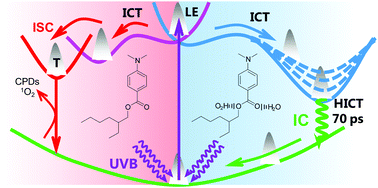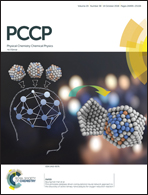Photoprotection or photodamage: a direct observation of nonradiative dynamics from 2-ethylhexyl 4-dimethylaminobenzoate sunscreen agent†
Abstract
Apart from being an analogue of the prototype for photoinduced intramolecular charge transfer (ICT), 2-ethylhexyl 4-dimethylaminobenzoate (EHDMABA) is also one of the earliest patented and most commonly used sunscreen components. There is, however, little documented information about the photophysics and factors affecting the photophysics of this molecule. Such information is of importance for both the understanding of the ICT reaction and assessing the underlying process of photoprotection, especially in view of the “sunscreen controversy” that has arisen from the contrasting in vivo vs. in vitro photobiological results on this and related UV filters. We report herein a femtosecond broadband time-resolved fluorescence (fs-TRF), complemented by transient absorption (fs-TA) to allow a full probe of the excited state cascades for EHDMABA and two of its derivatives in solvents of varied properties. The results provide direct evidence for a nearly solvent independent inner sphere ICT reaction occurring on the sub-picosecond time scale, and an ensuing solvent dictated deactivation of the ICT state. The ICT state in the aprotic solvent acetonitrile decayed solely through the intrinsic intersystem crossing (ISC) to produce a potentially harmful triplet excited state. In the protic solvent, the solvation and formation of ICT-induced solute–solvent hydrogen (H)-bonding opened the originally inaccessible internal conversion (IC) channel of the ICT state, leading to the rapid reformation of the ground state molecule with a unitary efficiency in the aqueous solution. This H-bonding-mediated IC restrained or eliminated the intrinsic ISC, providing a mechanism at the molecular level for the benign dissipation of the electronic excitation. The precise rate of IC was observed to vary with the alkoxy substituent and its efficiency was affected by the H-bonding capacity of the solvent. The findings of this work demonstrate the pivotal role of the microenvironment and the direct participation of solvent molecules through H-bonding in drastically altering the nonradiative dynamics and promoting or inhibiting photostability and photoprotection. This may assist in developing next-generation UV filters and help in improving formulation design for the optimal efficacy of sunscreen products. The pronounced H-bonding-induced fluorescence quenching and variation in the fluorescence wavelength imply that these molecules may also serve as a sensitive fluorescence probe for the H-bonding properties of the microenvironment.



 Please wait while we load your content...
Please wait while we load your content...